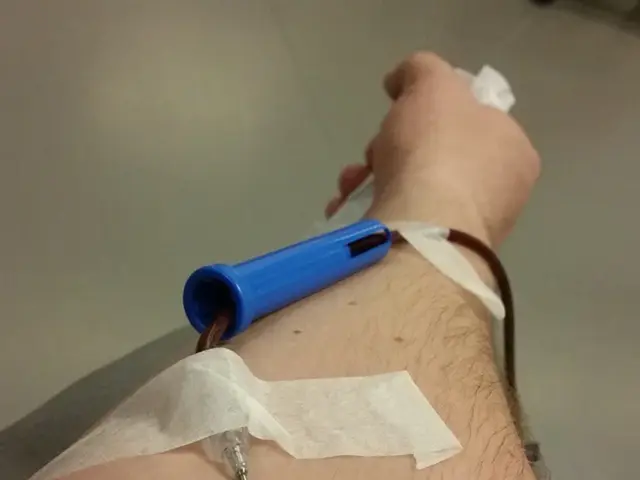Unveiling Hidden Sugars in Common Food Items: A Guide by Sugar Sleuth
Uncovering Hidden Sugars: A Guide to Making Healthier Choices
In today's fast-paced world, sugar can be found in a multitude of unexpected places, from cereals and sauces to snacks and beverages. To help identify sugar in everyday foods and empower readers to make healthier choices, here's a guide that unveils the many names sugar can take on food labels and offers strategies for reducing hidden sugars in your diet.
Sugar, often disguised under various names such as sucrose, fructose, glucose, high-fructose corn syrup, corn syrup, honey, agave nectar, molasses, dextrose, maltose, maple syrup, maltodextrin, fructose syrup, corn syrup solids, invert sugar, and fruit juice concentrates, can be deceptive on food labels [1][2][3]. So, it's essential to carefully read ingredient lists to spot these aliases and make informed decisions.
Paying attention to nutrition labels is equally crucial, especially on processed or packaged foods. Be mindful of the serving size on the label, and check the total sugar content per serving, especially on products like granola, flavoured yogurts, breads, energy bars, sauces, and even savoury items like ketchup and baked beans, which often contain unexpected sugars [1][4][5].
The American Heart Association recommends limiting added sugars to 6 teaspoons (25 grams) for women and 9 teaspoons (38 grams) for men [6]. Ingredients are listed in order of quantity on food labels, so if sugar or any of its aliases is among the first few ingredients, the product likely contains a significant amount.
To make informed choices for a healthier lifestyle, prefer whole, minimally processed foods such as whole wheat, rye, or pumpernickel bread, brown or wild rice, whole wheat pasta, and fresh fruits instead of juices or canned fruits in syrup [2][5]. Cooking from scratch and making your own sauces and dressings can help reduce hidden sugar intake [4]. Avoid foods marketed as “low-fat” where sugar is often added to compensate for flavour loss, and be wary of “healthy” snacks that may be high in sugars despite their claims [1].
Adopting a mindful eating approach can help make better food choices. Opt for natural sweeteners like stevia, monk fruit, or raw honey sparingly. Remember, exceeding the recommended limits of added sugars can lead to weight gain, diabetes, and other chronic diseases.
By being vigilant in examining food labels for hidden sugar names and choosing whole grains and fresh produce while reducing reliance on processed foods, you're on your way to identifying and reducing hidden sugars to support a healthier diet [1][2][3][4][5]. Happy and healthier eating!
[1] American Heart Association. (2021). Added Sugars. Retrieved from https://www.heart.org/en/healthy-living/healthy-eating/eat-smart/sugar/added-sugars
[2] Harvard T.H. Chan School of Public Health. (2021). Sugars. Retrieved from https://www.hsph.harvard.edu/nutritionsource/carbohydrates/sugars/
[3] Mayo Clinic. (2021). Sugar: How to cut back. Retrieved from https://www.mayoclinic.org/healthy-lifestyle/nutrition-and-healthy-eating/in-depth/sugar/art-20048298
[4] Centers for Disease Control and Prevention. (2021). Added Sugars. Retrieved from https://www.cdc.gov/healthyweight/healthy_eating/limits_added_sugars.html
[5] World Health Organization. (2021). Sugars intake for adults and children. Retrieved from https://www.who.int/nutrition/publications/guidelines/sugars-intake-for-adults-and-children/en/
[6] American Heart Association. (2021). How much added sugar should I eat per day? Retrieved from https://www.heart.org/en/healthy-living/healthy-eating/eat-smart/sugar/how-much-added-sugar-should-i-eat-per-day
- In the guide that unmasks the many aliases of sugar on food labels, sucrose, fructose, glucose, corn syrup, and molasses are some of the hidden sugars identified.
- To lower your hidden sugar intake, choosing whole wheat bread, brown rice, and fresh fruits instead of processed foods is recommended, as mentioned in the text.
- For a health-and-wellness conscious lifestyle, it is advised to limit added sugars to six teaspoons for women and nine teaspoons for men, as suggested by the American Heart Association in the provided resources.
- By cooking from scratch and making your own sauces and dressings, you can successfully reduce hidden sugar intake, as highlighted in the article.
- To make healthier diet choices, be aware of foods marketed as 'low-fat', as sugar is often added to compensate for flavour loss, according to the suggestions presented in the passage.




